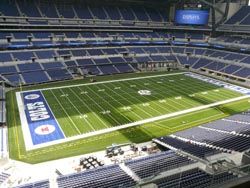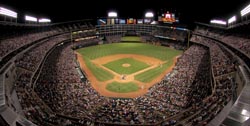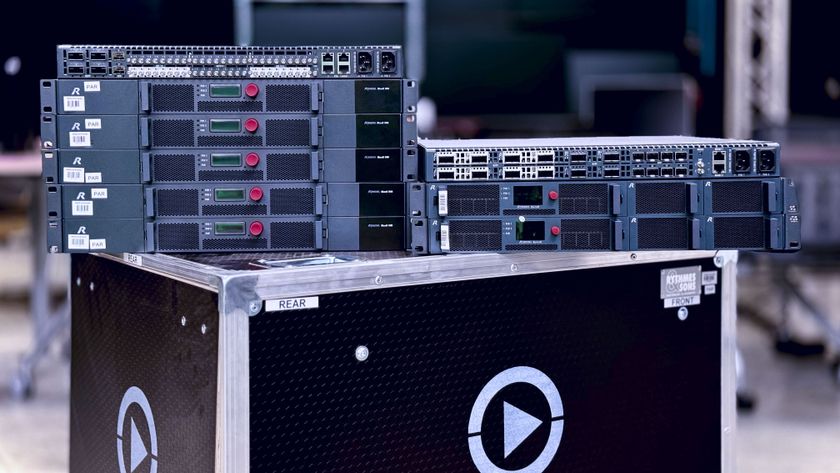The Texas Rangers Ballpark in Arlington recently updated its Electro-Voice sound system, which now includes 176 customized EV FRi+122 speakers.The Cowboys. The Colts. The Twins. Both of New York's Major League Baseball teams. They're all at it--building new stadiums, that is. Never mind the credit crunch, the soaring cost of energy, or fears about the state of the global economy. North America's sports industry is, metaphorically speaking, pulling on its uniform, taking one last sip of Gatorade, and going out to play like never before.
And the new-builds tell only part of the story. For every headline-making, iconic new architectural landmark, there are probably three or four major refurbishment programs taking place--or, at least, scheduled to take place--at arenas and ballparks across the land.
All this activity begs an obvious question. At a time when some other application sectors are, perhaps at best, treading water, why is the sports market proving so resilient? The simple answer is that, for team owners, new stadiums--with their larger capacities, more comfortable seating, enhanced catering options and so forth--can quickly pay for themselves. It's not just a case of getting more people to the game. Once they're inside, they're spending more money, too.
The past decade has seen the lines between sports and entertainment become increasingly blurred, and it is no longer enough for fans to be thrilled by the drama unfolding before them on the field. In fact, given the unpredictable nature of sports, off-field entertainment has a dual role to play: not only can it underline a team's success, it can also deflect attention from its failure.
Complete Package
Today, more than ever, AV technology has a key role to play when it comes to keeping sports fans entertained. When staff from Indianapolis-based integrator ESCO Communications first became involved with the project to build a new home for the Colts NFL franchise in the city, they were made aware of the importance of their role from a very early stage.
"We had a meeting with the Colts' senior management team, and their perspective was that the two most important systems in the new stadium would be audio and video," recalls Gary Dunn, executive vice president of business development at ESCO. "Football is not a poor people's game any more. People are paying high prices for tickets and, come game day, although the team has to perform, people also want to be entertained in other ways. The audio isn't just a question of getting the sound of an announcer's mic onto the seats so that the crowd can hear a call."
Lucas Oil Stadium, as the Colts' new home is to be called, is scheduled to be open in time for the start of the new NFL season. A seven-level arena, it will seat 63,000 for football but can be reconfigured to house upwards of 70,000 for NCAA basketball, concerts, and other events. It will also be linked via walkways to the newly reconfigured Indianapolis Convention Center when that facility's expansion is complete in 2010.
"Lucas Oil is unique, as far as I know, in having three tenants," said Dunn. "And what they all have in common is the need to put on a show. In breaks, in timeouts, the AV becomes a sellable commercial. They want people in that bowl, which is a captive audience, to see and hear sponsors' messages."
One manufacturer that knows the detail of this phenomenon perhaps more keenly than any other is Daktronics, the Brookings, SD-based manufacturer of scoreboards, video screens and other display systems. Mark Steinkamp, marketing manager of the company's Large Sports Venues division, feels that it's the changing expectations of sports fans themselves that are helping to drive up the quality of arena AV.

The past decade has seen the lines between sports and entertainment become increasingly blurred, and it is no longer enough for fans to be thrilled by the drama unfolding before them on the field. As Lucas Oil Stadium in Indianapolis continues construction, contractors and owners alike know that AV technology has a key role to play when it comes to keeping sports fans entertained.
Recently, Daktronics' most striking individual project along these lines has been the installation of a huge HD-X LED display structure for Kansas City Royals MLB team, measuring 105 feet high by 85 feet across.
The Royals see the screen as a key element in the refurbishment of their Kauffman Stadium home, as Kevin Uhlich, senior vice president, business operations, explained: "We installed the very latest video technology to provide the best game-day presentation for fans, in incredible detail that is larger than life. The sheer size of the main display allows us to show live and recorded video in high definition, while at the same time provides much more statistical information, graphics, animation, and other energizing content. Imagine replays, highlights, and images that are 100 feet tall. It is very impressive."
Daktronics is not the only large-screen supplier to be making hay while the sports sun shines. The Display Engineering division of Mitsubishi Electric recently signed two major new contracts for U.S. arenas. One is for a DiamondVision HD LED screen, measuring almost 100 feet wide and 60 feet high, at the new Yankee Stadium. The other is for a potentially ground-breaking center cluster of HD LED screens at the new Dallas Cowboys football stadium which, when taken together with its supporting hardware, will stretch all the way from one 20-yard line to the other.
The two sideline LED displays in Dallas are scheduled to be 160 feet wide by 72 feet high, while the two end zone walls will measure 50 feet wide by 30 feet high. And while the cluster will be an obvious visual centerpiece for the new arena, it will be augmented by Mitsubishi's LEDerAd fascia ribbon displays and some 3,000 flat screens throughout its concourse, concession, and VIP suite areas.
Gaining Flexibility
At one time, integrators would rightly have complained that team owners tended to obstruct plans to introduce the best technology into their arenas, applying pressure on everyone involved in the project--from the architects down--to cut costs. Even today, people like ESCO's Gary Dunn express gratitude, perhaps even relief, when the public funding associated with a project like the Lucas Oil Stadium wrests control away from a single, powerful individual.
Today, though, the argument can run the other way. Team owners like the Cowboys' Jerry Jones no longer need persuading that they will get a handsome ROI on their new AV systems. Indeed, Jones himself has played a pivotal role in the implementation of systems technology at the new home of the Cowboys.
"Our center-hung scoreboard is one of the central design elements of our new stadium," said Jones. "It's a unique feature that will be an iconic symbol of our building for years to come." But there are hard-headed business reasons, as well as aesthetic ones, for taking such a bold AV step. As Jones said of the thousands of fans who will be seated in front of the LED cluster: "They can't turn away, so you can hammer them with your message."
The same will be equally true even when those same fans leave their seats to buy something to eat, as Jones plans to use a proportion of those flat screens to display electronic menus which, among other things, will be able to direct customers from crowded stands to empty ones, or to offer specials to move unsold food late in games.
At Daktronics, Mark Steinkamp underlines the point that the developing story of AV in sports is not just a matter of bigger, brighter, and more dynamic scoreboards. "We have a broad product line from which we can design a system to meet the needs of any facility, from the largest HD LED screen to small, ticket-window message centers," he explained.
"The trend is definitely toward integration, and an all-digital system can provide a lot more flexibility for team and venue sponsors. They can change their messaging very quickly and inexpensively."
Sound Concerns
A similar flexibility is now also sought by sports customers when it comes to audio. But whereas the video trend is toward larger, more physically striking elements, for sound the opposite is true. The more compact a system is, the more likely it will satisfy the arena's needs.
"Speaker technology has changed significantly in the last 14 years," said Chris Jordan, chief steward and owner of Electro Acoustics, which recently upgraded the Electro-Voice sound system it originally installed at the Rangers Ballpark in Arlington, TX, when it first opened in 1994. "The latest generation of FRi loudspeakers offers a lighter weight, higher fidelity, more rigging-friendly solution than the previous system, but with that same inherent EV build quality and reliability.
"It was far easier to install three 60-pound speakers than a single, heavy unit, which also means they will be simpler to remove--if that's ever necessary. And, cosmetically speaking, this time we were able to fit the speakers higher up in the steel rafters, so they are far less visible."
Fresh from his own experience of being involved in the installation of a JBL-based audio system at the Lucas Oil Stadium (see sidebar), ESCO's Gary Dunn offers an additional perspective. While the sports market itself may be in resilient health, that health may also have positive repercussions for other AV markets. As he puts it:
"Any city that has professional sports is going to see spin-offs. In Indianapolis, they decided to focus on sports, and it's had a big impact in terms of the airport, the convention center, and new lodging and hospitality facilities being built. Now we've got the Superbowl in 2012, and that's going to bring even more spin-offs."
Anyone still say that it's all just a game?
Crown
Daktronics
Electro-Voice
JBL
Mitsubishi Electric













